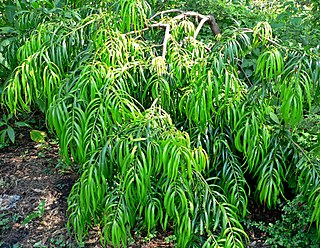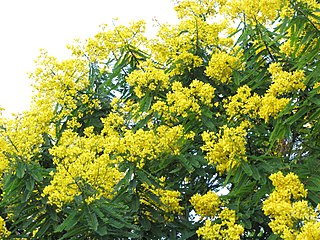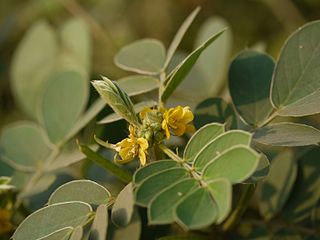Aspidosperma excelsum is a tree in the Dogbane family Apocynaceae which grows up to one hundred feet in height. It is native to Peru, Bolivia, Colombia, Venezuela, the Guianas, Panama, and Costa Rica. Its most interesting characteristic is its trunk, which has a deeply sinuous cross-section, usually described as stellate, It is thought these sinuosities offer some protection against strangling figs, Copay and other stranglers by making it more difficult to encircle the tree's cambium.

Podocarpus matudae is a species of conifer in the family Podocarpaceae. It is found in Guatemala, El Salvador, Honduras and Mexico.

Hedyosmum mexicanum is a species of plant in the family Chloranthaceae. It is found in Guatemala and Mexico. It is threatened by habitat loss.

Schaefferia frutescens, the Florida-boxwood, is a species of flowering plant in the family Celastraceae, that is native to tropical regions of the Americas, from southern Florida in the United States, south through the Caribbean to Central America and northwestern South America, and also Veracruz in Mexico. It grows at close to sea level in Florida, and up to 600 m altitude in Puerto Rico.

Plumeria rubra is a deciduous plant species belonging to the genus Plumeria. Originally native to Mexico, Central America, Colombia and Venezuela, it has been widely cultivated in subtropical and tropical climates worldwide and is a popular garden and park plant, as well as being used in temples and cemeteries. It grows as a spreading tree to 7–8 m (23–26 ft) high and wide, and is flushed with fragrant flowers of shades of pink, white and yellow over the summer and autumn.

Voyria, commonly known as ghostplants, is a genus of 20 species of herbaceous perennial plants, belonging to the family Gentianaceae. They are mostly native to warm temperate and tropical regions of the Caribbean, Central America and South America, except for V. primuloides, which is found in West and Central Africa. V. parasitica reaches as far north as the Everglades in Florida.

Stenocereus griseus, also known as the Mexican organ pipe, dagger cactus, pitaya, and pitayo de mayo, is a species of cactus.

Pittosporum viridiflorum is a protected tree in South Africa.
Myrospermum is a genus of flowering plants in the legume family, Fabaceae. It includes two species of trees and shrubs native to the tropical Americas, ranging from northeastern Mexico through Central America to Colombia and Venezuela. Typical habitats include seasonally-dry tropical to subtropcial woodland and bushland, often on rocky hillsides and along rivers and streams.

Terminalia buceras is a tree in the Combretaceae family. It is known by a variety of names in English, including bullet tree, black olive tree, gregorywood, Antigua whitewood, and oxhorn bucida. It is native to Mexico, Central America, the Caribbean, and northern South America. It is commonly found in coastal swamps and wet inland forests in low elevations.

Dioscorea altissima is a herbaceous vine in the genus Dioscorea that is indigenous to forested areas of Brazil, Bolivia, Peru, Central America north to Panama, and the Caribbean. Its tubers are foraged and cooked for human consumption, and they are also cultivated in Brazil on a small scale. This species has been introduced to Puerto Rico.
Magnolia mexicana, the Mexican magnolia, is a species of magnolia that is found in parts of Mexico, Guatemala and Honduras. The flower is known in parts of Mexico as yolloxochitl, an Aztec word that loosely translates to heart-shaped flower. The Mexican magnolia, often described as having a strong beautiful scent, has been used throughout the years for its medicinal properties, as it is said to have similar compounds to that of the Digitalis medication.

Moquilea platypus, also known as sun sapote, sansapote, and monkey apple, is a flowering tree in the family Chrysobalanaceae. The specific epithet (platypus) is Neo-Latin for "flat-footed".

Dialium guianense is a species of tree in the flowering plant family Fabaceae. The species occurs through North America, Central America and South America, and was an important source of food and wood for the ancient Mayans.

Astrocaryum mexicanum, the chocho palm, cohune palm, or chapay, is a species of cocosoid palm in the family Arecaceae, native to Mexico and Central America. It is very long-lived for a palm, reaching 140 years. Local people harvest its young inflorescences, its seeds, and its hearts for food. Covered with stout spines, it is hardy to USDA zone 10a, and is occasionally planted as an ornamental in places such as Hawaii and Southern California.

Smilax officinalis is a species of flowering plant in the family Smilacaceae, native to southern Central America and northwest South America; Honduras, Nicaragua, Costa Rica, Panama, Colombia, and Ecuador. A vine reaching 50 m (160 ft) as it climbs trees into the canopy, its roots are collected and used to make traditional medicines and, like other Smilax species, the soft drink sarsaparilla.

Senna multijuga, commonly known as November shower or false sicklepod, is a species of flowering plant in the family Fabaceae. It is native to wet tropical areas of Latin America, and widely introduced to other tropical locales such as Africa, India, Indonesia, China, Australia, and Hawaii. A fast-growing tree typically 10 m (33 ft) tall, it is planted in restoration projects, as an ornamental, and as a street tree, being especially useful under power lines.

Hymenaea oblongifolia is a widespread species of flowering plant in the family Fabaceae, native to the várzea forest ecosystem of northern and western South America. A tree reaching 40 m (130 ft), it is harvested for its timber, and its edible fruit is also collected in the wild for sale. It is used as a street tree in Medellín, Colombia.
Senna atomaria, the flor de San Jose, is a species of flowering plant in the family Fabaceae, native to Mexico, Central America, the Caribbean, Colombia, and Venezuela. A shrub or small tree, it is considered a multi-purpose species; fuel, wood, biomass, soil improvement, medicine, and ornament.

Senna uniflora, the oneleaf senna, is a species of flowering plant in the family Fabaceae. It is native to Mexico, Central America, the Caribbean, Colombia, Venezuela, and most of Brazil, and has been introduced to India, Mauritius, and Réunion. Although it is somewhat weedy and invasive, it is used to out-compete the pernicious weed Parthenium hysterophorus.















